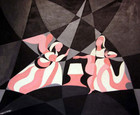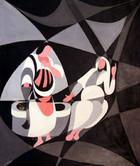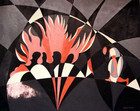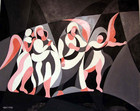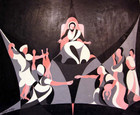Miguel Deveze
Modern Art does not have to be a medium without a message. Take a look at the work of Miguel Deveze, a French-Catalan artist born in Arles, France, in 1909. Deveze was an accomplished saxophone player in the Paris jazz scene, when an encounter with a Rubens painting at the Louvre persuaded him his real calling in life was to look for harmonies and syncopated rhythms in the geometric forms of visual art. Fascinated with modern industrial design, the self-taught Deveze developed an idiosyncratic style, often called “post-cubist,” where the figurative elements in his work emerge from contrasting planes of flat color, fitted precisely together like jigsaw puzzle pieces.
Deveze has painted a variety of subjects from high-speed trains to the intricate dance of matador and beast in the bull-ring, but he has a special love for the colorful Biblical narratives he heard growing up in Spain and Provence. His modernistic treatment of these sacred stories links him to the post-war revival of sacred art in France, led by Dominican Father Marie-Alain Couturier, who commissioned ecclesiastical works from cutting-edge contemporary artists like Leger, Chagall, Rouault, Bonnard, and Matisse. Sacred art pilgrims will definitely want to visit Matisse’s Chapel of the Rosary at Vence, near Nice, then, travel on to Arles to view Deveze’s Stations of the Cross in the Church of Saint-Pierre-de-Trinquetaille, thought by some art critics to be his masterpiece.
